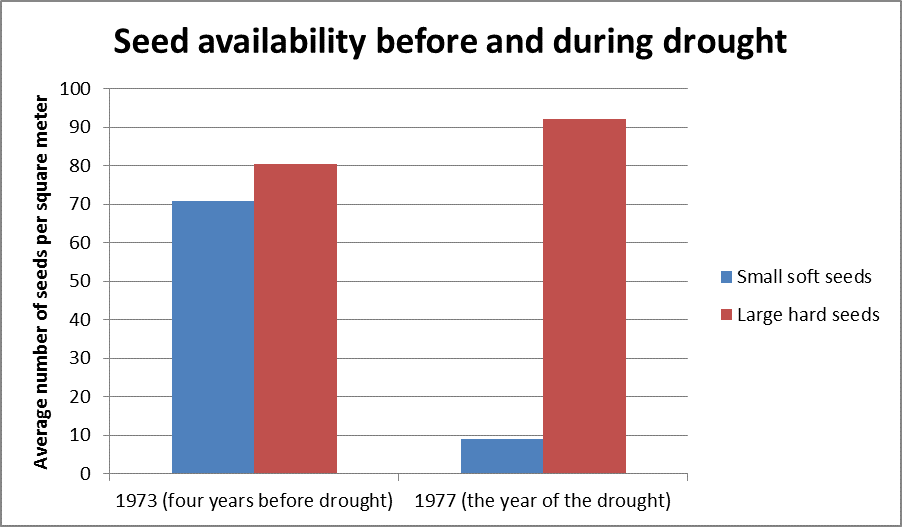Item EN070003: Environmental change (drought) that affects the types of seeds available to birds can affect the distribution of birds' beak size in future generations.
Scientists have been studying a population of ground finches on one island for more than 40 years. In 1977, a drought (a long period without rain) killed certain types of plants on the island. Otherwise, everything else in the finches' environment stayed about the same.
To study how the drought might affect ground finches, scientists examined the food available to finches before and during the drought. In both years, they counted the number of large hard seeds and small soft seeds available to finches per square meter.

Could the changes that occurred in the types of seeds that were available affect the distribution of beak sizes in future generations of this population?
- Yes, because the change in seed types could cause new genetic variations in beak size to appear. These genetic variations did not exist before the drought.
- Yes, because the change in seed types could affect the survival advantage of different beak sizes. These variations in beak size existed before the drought.
- Yes, because the change in seed types could cause natural selection to begin acting on beak size. Natural selection was not acting on beak size before the drought.
- No, the change in seed types would have no effect on the distribution of beak sizes in this population of ground finches.
Pre-Test
Answer Choice |
Overall |
Grades |
Gender |
Primary Language |
||||
|---|---|---|---|---|---|---|---|---|
| n = 0 |
6–8 n = 0 |
9–12 n = 0 |
Male n = 0 |
Female n = 0 |
English n = 0 |
Other n = 0 |
||
| A. | Yes, because the change in seed types could cause new genetic variations in beak size to appear. These genetic variations did not exist before the drought. | NAN% | NAN% | NAN% | NAN% | NAN% | NAN% | NAN% |
| B. | Yes, because the change in seed types could affect the survival advantage of different beak sizes. These variations in beak size existed before the drought. | NAN% | NAN% | NAN% | NAN% | NAN% | NAN% | NAN% |
| C. | Yes, because the change in seed types could cause natural selection to begin acting on beak size. Natural selection was not acting on beak size before the drought. | NAN% | NAN% | NAN% | NAN% | NAN% | NAN% | NAN% |
| D. | No, the change in seed types would have no effect on the distribution of beak sizes in this population of ground finches. | NAN% | NAN% | NAN% | NAN% | NAN% | NAN% | NAN% |
Post-Test (Control)
Answer Choice |
Overall |
Grades |
Gender |
Primary Language |
||||
|---|---|---|---|---|---|---|---|---|
| n = 274 |
6–8 n = 14 |
9–12 n = 230 |
Male n = 119 |
Female n = 130 |
English n = 237 |
Other n = 9 |
||
| A. | Yes, because the change in seed types could cause new genetic variations in beak size to appear. These genetic variations did not exist before the drought. | 22% | 29% | 20% | 21% | 21% | 22% | 22% |
| B. | Yes, because the change in seed types could affect the survival advantage of different beak sizes. These variations in beak size existed before the drought. | 50% | 36% | 51% | 55% | 45% | 50% | 56% |
| C. | Yes, because the change in seed types could cause natural selection to begin acting on beak size. Natural selection was not acting on beak size before the drought. | 27% | 29% | 27% | 20% | 34% | 27% | 0% |
| D. | No, the change in seed types would have no effect on the distribution of beak sizes in this population of ground finches. | 2% | 7% | 2% | 4% | 0% | 1% | 22% |
Post-Test (Treatment)
Answer Choice |
Overall |
Grades |
Gender |
Primary Language |
||||
|---|---|---|---|---|---|---|---|---|
| n = 278 |
6–8 n = 4 |
9–12 n = 248 |
Male n = 130 |
Female n = 131 |
English n = 251 |
Other n = 5 |
||
| A. | Yes, because the change in seed types could cause new genetic variations in beak size to appear. These genetic variations did not exist before the drought. | 15% | 50% | 15% | 14% | 18% | 16% | 0% |
| B. | Yes, because the change in seed types could affect the survival advantage of different beak sizes. These variations in beak size existed before the drought. | 53% | 50% | 52% | 55% | 49% | 54% | 20% |
| C. | Yes, because the change in seed types could cause natural selection to begin acting on beak size. Natural selection was not acting on beak size before the drought. | 29% | 0% | 31% | 30% | 30% | 28% | 80% |
| D. | No, the change in seed types would have no effect on the distribution of beak sizes in this population of ground finches. | 3% | 0% | 3% | 1% | 4% | 3% | 0% |

